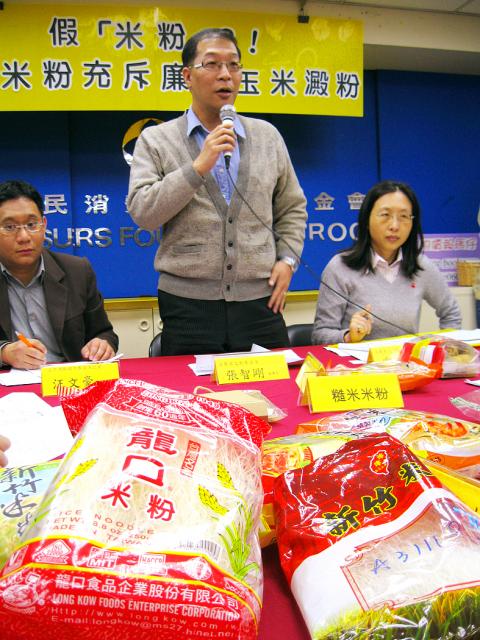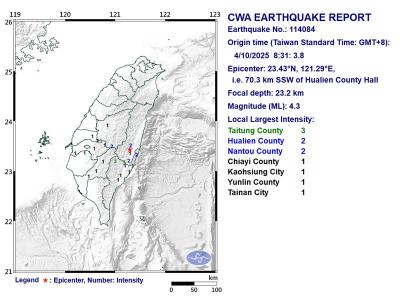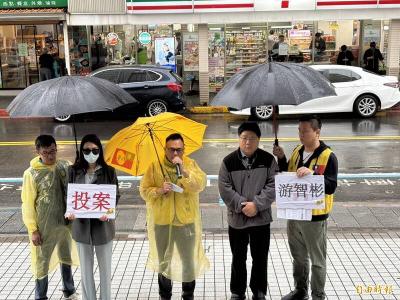Nearly 90 percent of rice vermicelli noodles are not primarily composed of their main ingredient, rice, but are instead a mix of other edible starches, the Consumers’ Foundation said yesterday.
According to the Chinese National Standard (CNS) No. 11172, there are two types of rice vermicelli: one are pure vermicelli, which are made of from rice and more than 5 percent crude protein, and the other is mixed rice vermicelli, which are more than 50 percent rice, mixed with flour or other edible starches and have more than 2.5 percent crude protein.
The foundation said a test on 52 types of rice vermicelli conducted by Internet agricultural news platform News & Market from Dec. 29 last year to Jan. 14 this year showed that 45 of the products tested (about 86.5 percent) were comprised of less than 50 percent rice, while 39 products (75 percent) were less than 20 percent rice.

Photo: Hsieh Wen-hua, Taipei Times
Citing the survey, the foundation said that LongKow noodles, a famous brand from Hsinchu, were made up of between 7 percent and 10 percent rice, despite the claim on the packages that they are 90 percent rice.
Three types of noodles from Hsinchu-based Nung-Keng claimed to meet the CNS11172 standard on their packages, but results showed that the noodles were less than 10 percent rice and contained crude protein of between 0.3 percent and 0.5 percent, it said.
Foundation chairman Mark Chang (張智剛) said that the products that do not meet the required standards should be recalled and their manufacturers fined for false labeling.
The Food and Drug Administration said companies should give accurate information about their products, as stipulated by the Act Governing Food Sanitation (食品衛生管理法), and that it would investigate the noodles sold in stores for false labeling.

Taiwan is stepping up plans to create self-sufficient supply chains for combat drones and increase foreign orders from the US to counter China’s numerical superiority, a defense official said on Saturday. Commenting on condition of anonymity, the official said the nation’s armed forces are in agreement with US Admiral Samuel Paparo’s assessment that Taiwan’s military must be prepared to turn the nation’s waters into a “hellscape” for the Chinese People’s Liberation Army (PLA). Paparo, the commander of the US Indo-Pacific Command, reiterated the concept during a Congressional hearing in Washington on Wednesday. He first coined the term in a security conference last

A magnitude 4.3 earthquake struck eastern Taiwan's Hualien County at 8:31am today, according to the Central Weather Administration (CWA). The epicenter of the temblor was located in Hualien County, about 70.3 kilometers south southwest of Hualien County Hall, at a depth of 23.2km, according to the administration. There were no immediate reports of damage resulting from the quake. The earthquake's intensity, which gauges the actual effect of a temblor, was highest in Taitung County, where it measured 3 on Taiwan's 7-tier intensity scale. The quake also measured an intensity of 2 in Hualien and Nantou counties, the CWA said.

The Overseas Community Affairs Council (OCAC) yesterday announced a fundraising campaign to support survivors of the magnitude 7.7 earthquake that struck Myanmar on March 28, with two prayer events scheduled in Taipei and Taichung later this week. “While initial rescue operations have concluded [in Myanmar], many survivors are now facing increasingly difficult living conditions,” OCAC Minister Hsu Chia-ching (徐佳青) told a news conference in Taipei. The fundraising campaign, which runs through May 31, is focused on supporting the reconstruction of damaged overseas compatriot schools, assisting students from Myanmar in Taiwan, and providing essential items, such as drinking water, food and medical supplies,

New Party Deputy Secretary-General You Chih-pin (游智彬) this morning went to the National Immigration Agency (NIA) to “turn himself in” after being notified that he had failed to provide proof of having renounced his Chinese household registration. He was one of more than 10,000 naturalized Taiwanese citizens from China who were informed by the NIA that their Taiwanese citizenship might be revoked if they fail to provide the proof in three months, people familiar with the matter said. You said he has proof that he had renounced his Chinese household registration and demanded the NIA provide proof that he still had Chinese